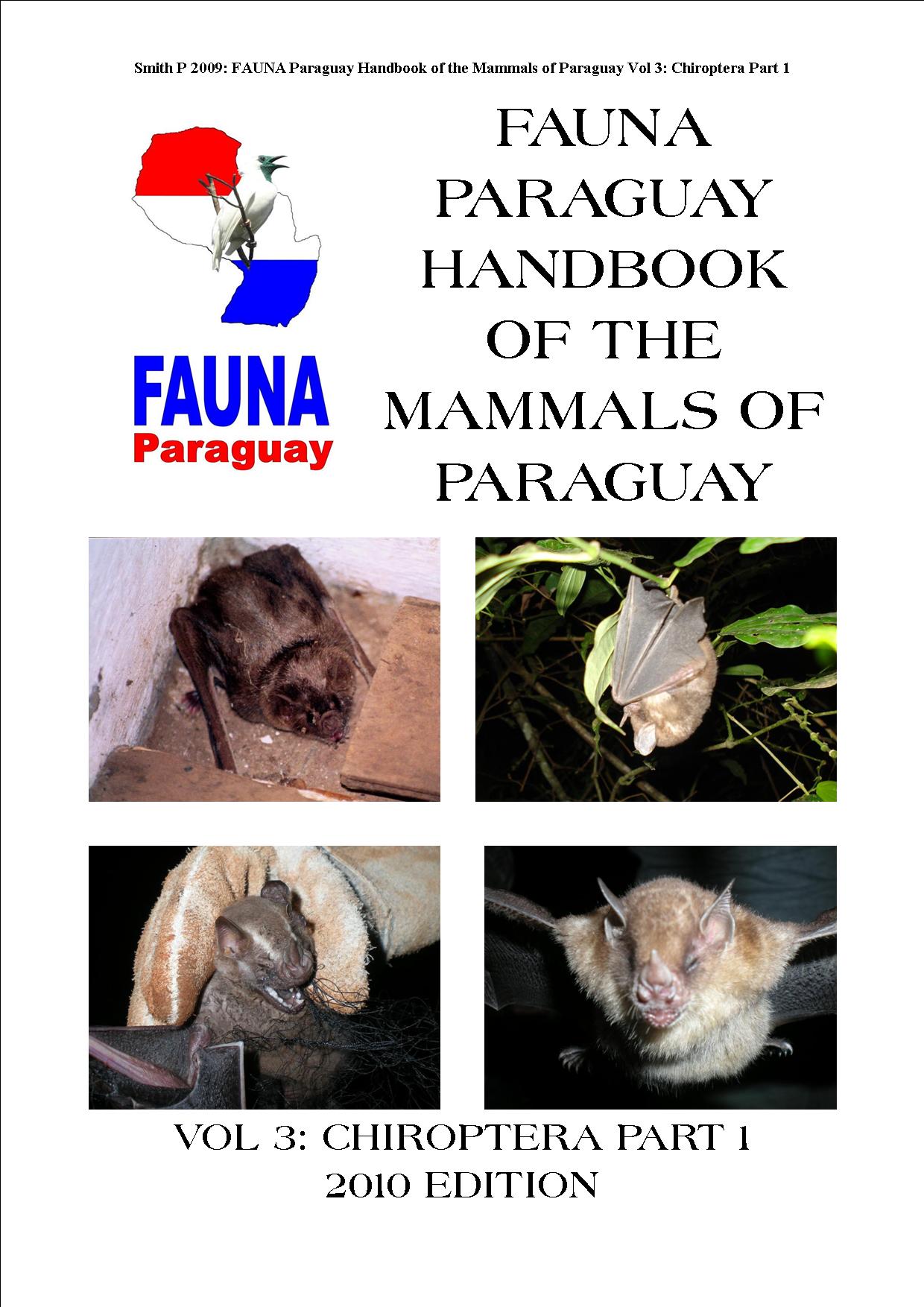
Designed by Paul Smith 2006. This website is copyrighted by law.
Material contained herewith may not be used without the prior written permission of FAUNA Paraguay.
Photographs on this web-site were taken by Paul Smith, Hemme Batjes, Regis Nossent,
Alberto Esquivel, Arne Lesterhuis, José Luis Cartes, Rebecca Zarza and Hugo del Castillo and are used with their permission.
Click on the species links for access to the image gallery.
Click on the HBook icon on the right hand side for access to pdfs of the FAUNA Paraguay Handbook of the Mammals of Paraguay Volume 3 Chiroptera Part 1: Emballonuridae, Noctilionidae and Phyllostomidae.
See below for a key to the Paraguayan species.
NOCTILIONIDAE - BULLDOG BATS
General characteristics: Two similar species of large bat classified in the same genus and best distinguished from each other by their relative size and foot length. Bats of this family are immediately distinguished in the hand by their unique “hare-lip” which exposes the large canines. Chhecks and lips are elastic and can be expanded to form cheek pouches. There is no true nose leaf, though a small fleshy projection at the tip of the snout may be mistaken for a nose leaf. The tail is short, about half the femoral length, and emerges on the dorsal side of the uropatagium about half way along its length. The foot is equipped with flattened, hooked claws and an exceptionally elongated, flattened calcaneous which is used to scoop the prey from the water - all other bats approach water mouth first. The wing and tail membranes are semi-translucent. Both species have long, tubular, ears, well-separated and with a small, serrated tragus. The ears are pointed at the tips and angled slightly forward. The pelage of the dorsum is short and velvety, often with exposed bare patches, particularly at the sides of the lower back. Bats of this family have a strong musky odour. Fossil remains are known from the Pleistocene of the West Indies.
Cranial characteristics: Short snout, somewhat rounded. Deep, ovaloid brain case with well-developed sagittal crest (particularly in the male). No postorbital processes. In adults premaxillaries are fused medially to each other and to the maxillary. Palate completely closed anteriorly. Mastoid region is elongated laterally and shelf-like.
Dental characteristics: Dental formula I2/1 C1/1 P1/2 M3/3 = 28.
Skeletal characteristics: The third finger has three phalanges, digits II and IV hav two, the second of which folds under the first when the bat is at rest. Fibula elongated, fibrous and cartilaginous proximally. Humerus only slightly articulated with scapular and with trochanter smaller than trochin. Spinous process of humerus well-developed and capitulum off line with humeral shaft. Seventh cervical vertebrae not fused to first thoracic. Pelvis with ischia fused and contacting urostyle-like sacrum.
Noctilio Linnaeus, 1766: Bulldog Bats
There are two species in this genus, both are present in Paraguay. Synonyms adapted from Gardner (2007).
Synonyms:
Vespertilio Linnaeus 1758:32. In part.
Noctilio Linnaeus 1766:88. Type species Noctilio americanus Linnaeus (1766) by monotypy.
Pteropus Erxleben 1777:130. In part.
Noctileo Tiedemann 1808:536. Incorrect spelling.
Celaeno Leach 1821:69. Type species Celaeno brooksiana Leach (1821) by monotypy.
Celano Gray 1825:243. Incorrect spelling.
Caelano Gray 1825:339. Incorrect spelling.
Noctillo Burmeister 1879:3. Incorrect spelling.
Noctitio Beckstein 1801:213. Incorrect spelling.
Dirias Miller 1906:84: Type species Noctilio albiventer Spix (1823) by original description.
General characteristics: This is the only genus in this family and characteristics are given in the family account above.
Noctilio albiventris - Lesser Bulldog Bat
Noctilio leporinus - Greater Bulldog Bat
Key to Adults of Bulldog Bats
1a Forearm length >80mm. Hindfoot length>28mm. Combined length of the tibia and hindfoot is greater than 80% of the forearm length. Wingspan c500mm. Weight c50g......................................Noctilio leporinus
1b Forearm length <70mm. Hindfoot length <27mm. Combined length of the tibia and hindfoot is less than 70% of the forearm length. Wingspan c400mm. Weight c40g....................................Noctilio albiventris
REFERENCES
Barquez RM, Giannini MP & Mares MA 1993 - Guía de los Murciélagos de Argentina - University of Oklahoma.
Diaz MM & Barquez RM 2002 - Los Mamíferos de Jujuy, Argentina - LOLA.
Emmons LH & Feer F 1999 - Mamíferos de los Bosques Húmedos de América Tropical - FAN Bolivia.
Gardner AL 2007 - Mammals of South America Volume 1: Marsupials, Xenarthrans, Shrews and Bats - University of Chicago Press.
Hood CS, Knox Jones Jr J 1984 - Noctilio leporinus - Mammalian Species 216.
Hood CS, Pitocchelli J 1983 - Noctilio albiventris - Mammalian Species 197.
López-González C 1998 - Systematics and Zoogeography of the Bats of Paraguay - PhD Thesis Texas Tech University
López-González C 2005 - Murciélagos del Paraguay - Biosfera 9.
Redford K 1992 - Mammals of the Neotropics Vol 2: The Southern Cone Chile, Argentina, Uruguay and Paraguay - University of Chicago Press.




